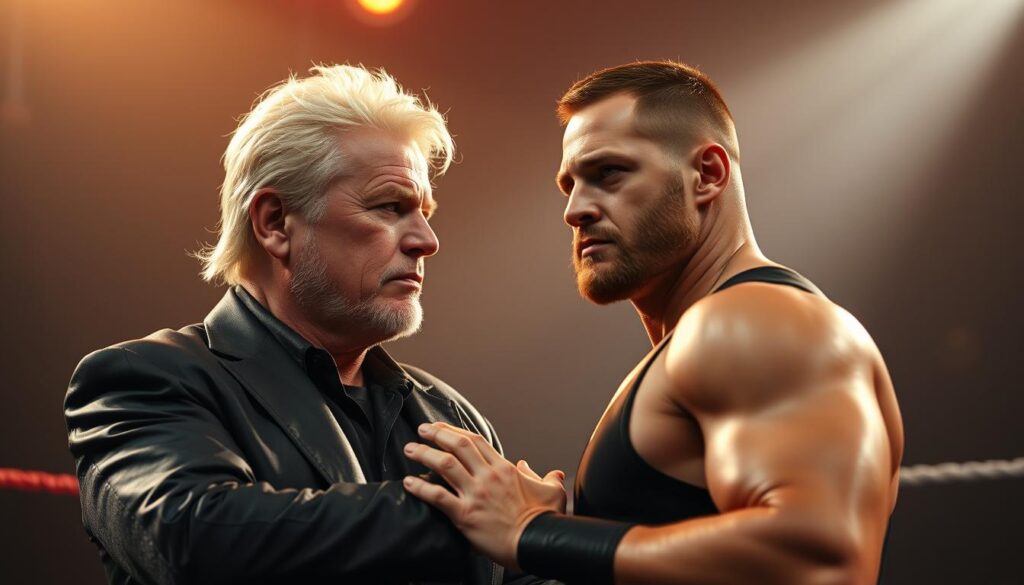What makes a 76-year-old wrestling legend like Ric Flair so relevant today? Born in 1949, he became a symbol of excess and extravagance. He’s the only WWE Hall of Famer inducted twice, once for his wrestling skills and once for his outrageous lifestyle.
His career lasted an incredible five decades, earning him 16 world titles. Today’s wrestlers might drop belts quickly, but Flair’s reign was unmatched. He once said, “You don’t retire from being awesome – awesome retires you.”
Ric Flair is more than just a wrestler. He’s a study in how ego can outlast even the most basic human needs. Ready to learn why he’s the ultimate wrestling icon? Let’s dive in.
Early Life and Entry into Wrestling
Before Ric Flair became famous, he was Fred Phillips. His story is like something out of Elden Ring. Born in 1949 Tennessee, he grew up in Minnesota. His adoption was as mysterious as a good DLC.
His first wrestling role was as a 300lb bouncer. He was new to wrestling, like a “green as a WoW noob”. But then, a 1975 plane crash changed everything. It broke his back and made him rethink his approach.
After the crash, he became a lean, mean wrestling machine. He wore bleach-blonde hair and flashy robes. He’d later dominate WCW legends and NWA champions.
| Attribute | Fred Phillips | Ric Flair |
|---|---|---|
| Origin Story | Adopted kid from Minnesota | Self-proclaimed “stylin’, profilin’ jet-flyer” |
| Signature Move | Bouncer’s brute strength | Figure-Four Leg Lock (precision torture) |
| Recovery Arc | 9 months post-crash rehab | Became wrestling’s ultimate glass cannon |
This wasn’t just a change in clothes. It was a complete persona override. The crash was his chance to start anew as the “Nature Boy.” It was like switching from Strength to Dexterity/Charisma overnight.
His training under Verne Gagne was just the beginning. By joining the NWA, Flair became a master of strategy. He showed that being smart and stylish could be just as powerful as brute strength.
Defining Moments in Ric Flair’s Career
Ric Flair’s career is like a flawless video game run. No cheats needed, just his signature style and a bunch of championship belts. Let’s explore the key moments that made “The Nature Boy” a legend in wrestling.
NWA, WCW, WWE Championships: The Never-Ending Grind
Flair’s title wins are endless, like your uncle’s fishing stories. Officially, he’s won 16 world titles. But unofficially, it’s more like 25. Here’s a closer look:
| Promotion | Title Wins | Key Moment |
|---|---|---|
| NWA | 8 | 1981 “Real World Title” unification |
| WCW | 6 | 1991 “Clash of the Champions” vs. Sting |
| WWE | 2 | 1992 Royal Rumble MVP performance |
The 1991 match against Sting was more than a fight. It was like the first big esports rivalry. Flair made WCW exciting, like a must-have game.
“Woooo!” – The Ultimate Emote
Flair’s “Woooo!” became a staple in wrestling, like the Mario coin sound in games. It’s everywhere, from Snoop Dogg to Migos. Even your aunt Karen uses it.
But did you know Flair stole the “Woooo!” from Jerry Lewis? It’s like a rare loot drop. His character work inspired many, making him a true legend.
Signature Matches and Feuds
If wrestling were a fighting game, Ric Flair’s rivalries would be the secret boss battles you brag about beating. These battles leave your thumbs sore and your ego inflated. Let’s explore three feuds that redefined what it means to be sports-entertainment royalty. They have more twists than a FromSoftware lore dump.
Dusty Rhodes: The Brawler vs. The Stylin’ Professor
Flair’s feud with Dusty Rhodes was a 1980s clash of styles. Rhodes was the blue-collar “American Dream” while Flair was the champagne-sipping elitist. Their 1986 Great American Bash cage match was a survival test. Rhodes’ brawling met Flair’s technical mastery in a 23-minute epic.
This match made today’s ”rising stars wrestling” look like tutorial levels. It was a true masterclass.
Ricky Steamboat: The Dark Souls of Wrestling Rivalries
Flair’s 1989 trilogy with Ricky “The Dragon” Steamboat was a precision platforming experience. Their Chi-Town Rumble match was so technically perfect, it should’ve had a difficulty slider. It had more counter-attacks than a Street Fighter EVO final.
This wasn’t just storytelling; it was a ”no-hit run” of emotional stakes. Flair’s post-match promo was legendary: ”You beat me, Ricky… but I’m stil the World Heavyweight Champion!” It was the ultimate strut.
Sting: WCW’s Ultimate Boss Battle
When Sting descended in black-and-white facepaint, Flair faced his final boss. Their 1994 Clash of the Champions match was faction warfare DLC. It had:
- Four Horsemen NPCs (constantly respawning)
- Dramatic health-bar depleting moves (top-rope superplexes)
- A storyline so addictive, it made ”season pass” content look lazy
This rivalry didn’t just main-event pay-per-views. It created the blueprint for modern wrestling’s cinematic entrances and faction warfare. Take notes, ”rising stars wrestling” crews – this is how you build legacy XP.
Influence on Future Generations
If wrestling were an MMORPG, Ric Flair would be the raid boss who drops legendary loot and teaches you how to equip it. His career wasn’t just about piledrivers and promo-craft—it was a masterclass in building wrestling’s next-gen meta. Let’s dissect how “The Dirtiest Player in the Game” became its most generous sensei.
Training: From Horsemen to Headliners
The Four Horsemen weren’t just a faction—they were wrestling’s original toxic guild. Flair’s crew set the blueprint for every heel stable from nWo to The Bloodline, proving villains need charisma stats maxed out. But behind the limousine-riding, jet-flying facade? A shockingly open playbook.
Triple H credits Flair for teaching him how to “work smart, not hard” during their Evolution days. Batista also quotes Flair’s advice: “Make ‘em hate your guts, then make ‘em cheer when you lose.” Unlike some veterans who gatekeep like overzealous dungeon masters, Flair became the high-level player who shares XP potions.
Mentorship: Nicest Heel in the Business
Here’s the twist: Wrestling’s most notorious villain might be its kindest mentor. AEW’s rising stars get unsolicited Flair DMs analyzing their matches—like getting strategy guides from the final boss. One indie wrestler joked, “He’ll roast your gear mercilessly backstage, then slip you $500 for new tights.”
This duality explains why “nicest and rudest wrestlers off screen” debates always namecheck Flair. He’s equal parts:
- Brutal match critic (“You sold that punch like a toddler!”)
- Generous career coach (“Call me when you need contract advice”)
Character Work: The Flair Blueprint
Every robe-swishing entrance today owes royalties to Flair’s $10,000 suits. His “stylin’ and profilin’” persona became wrestling’s default charisma build—copied by everyone from Adam Cole’s Panama Sunrise swagger to MJF’s scarf-based villainy.
Charlotte Flair’s career proves wrestling genetics work better than any XP boost. But here’s the kicker: She trained under her dad’s rivals to avoid nepotism accusations. Result? A 13-time women’s champion who out-Flairs Flair—complete with strut upgrades and improved taunt animations.
As one WWE producer told us: “Modern wrestling isn’t just ‘inspired’ by Flair—it’s running mods on his original code.” From NXT call-ups to AEW’s main eventers, everyone’s grinding to reach Nature Boy levels.
Flair’s Cultural and Industry Impact
Ever wonder how a wrestling icon becomes a cultural cheat code? Ric Flair didn’t just “wooo” his way into the Hall of Fame – he hacked the matrix. Unlike others, Flair’s real-life persona and on-screen character merged perfectly. This created a blueprint so iconic, even Overwatch’s Junkrat stole his sequined swagger.
Flair’s post-retirement hustle was unlike anything else. While today’s athletes slap their names on Fortnite skins, Flair turned “stylin’ and profilin’” into a business strategy. His WOOOO Energy drink partnership? That’s not hydration – it’s liquid charisma in a can. Sponsorships with the Cleveland Cavaliers? That’s DLC for his legacy.
But here’s the twist: Flair’s WCW presidency makes Cyberpunk 2077’s launch look polished. Imagine letting a max-level player run the game studio – that’s what happened when WCW handed him creative control. Backstage politics became glitchier than a WWE 2K character model, proving even legends shouldn’t play Civilization with real companies.
The true magic? Flair’s persona became the ultimate character skin. From Dapper Dan disciples to TikTokers doing the strut, his influence outlasted wrestling itself. While other icons get reduced to nostalgic emote packs, Flair’s updates keep coming. Next time you see a streamer rocking flamboyant robes, remember: that’s not just fashion. That’s the Nature Boy expansion pack.
Reflecting on Ric Flair’s Legacy
Is Ric Flair the GOAT or just pro wrestling’s loudest peacock? He has 16 world titles and 50 years of limousine-riding, jet-flying chaos. His “Woooo!” is like a broken soundboard at a rave.
In a Ric Flair analysis, his style is undeniable. But does it outweigh substance? Kurt Angle’s Olympic mat mastery is a different story. Angle’s six suplexes could snap a spine; Flair’s strut could break a mirror.
Current wrestlers like Seth Rollins study Flair’s playbook. “Flair made arrogance an art form—you either study it or get left crying in face paint.” He’s a two-time Hall of Famer with more five-star matches than some promotions have pay-per-views.
Yet, could today’s locker rooms handle a new Nature Boy? Imagine Flair on TikTok, dropping “stylin’ and profilin'” takes between sensitivity trainings. He turned questionable life choices into championship gold—a hustle that’d get canceled fast.
Legendary wrestlers and their impact often fade, but Flair’s legacy lives on. He’s wrestling’s Shakespeare—if Shakespeare drank moonshine, bled in 60-minute broadways, and made falling off turnbuckles look like ballet. Love him or loathe him, the Space Mountain ride ain’t stopping—and neither will debates about where he stands in the pantheon. Pass the tissues, Dusty—we’re not done arguing yet.

